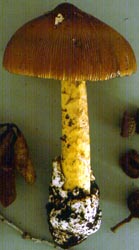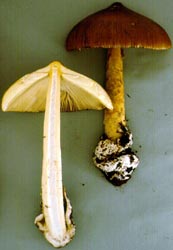|
[ Section Caesareae page. ]
[ Amanita Studies home. ]
[ Keys & Checklist/Picturebooks ] "Garabito's Slender Caesar"
Technical description (t.b.d.) BRIEF DESCRIPTION: The cap of Amanita garabitoana is 60 - 212 mm wide, campanulate to strongly convex, finally plano-convex with a slightly depressed center, with a large broad, but subpointed, umbo, viscid when moist, often dull, subglabrous to glabrous, suggesting a fine frost over the center, with a strongly striate to plicate striate margin. The cap is orange brown to olivaceous yellow or yellowish brown to orangish yellow, darkest over the center (for example, olive brown to orange brown to red brown) often with a dark circle at the inner end of the marginal striations. Volva is are absent. The flesh is white to dirty white to pale yellowish white, except yellow to pale yellow under the cap skin in the center just above the stem. The gills are adnate to narrowly adnate to free, close to crowded, faintly pinkish cream to pale orange cream to pale yellow cream to pale yellow in mass, 4.5 - 23 mm broad, thin to moderately thick and occasionally forked toward the stem or margin, sometimes with a short and very faint, decurrent line on the stem. The short gills are rounded truncate to subtruncate to truncate, plentiful, of diverse lengths, and unevenly distributed. The stem is 95 - 258 × 15 - 24 mm, light orange yellow to pale yellow to buff to yellowish white to off-white, yellow and frosty looking at the top of stem, unchanging or becoming more orange or more sordid with age, cylindric to narrowing upward, barely or not flaring at top, with a saccate, membranous, soft, white volva almost always connected at only the base of the stem. The flesh of the volva is white, 1.4 - 4 mm thick; the limbus internus is not always distinct or well-preserved, largely white or same material decorating the stem. Below the ring, the stem is decorated with dry scales, ochraceous to dull brownish orange to light orange brown to yellow, darkening from handling. The flesh is white to pale yellow to pale yellow orange, unchanging, stuffed with glistening white fibrillose material, becoming hollow. The ring is light yellow to slightly greenish yellow to sordid yellow to moderate yellow, subsuperior to apical, membranoius, thin, ample, skirt-like, persistent, striate on the upper surface, smooth below. The spores measure (7.5-) 8.0 - 11.0 (-13.6) × (5.7-) 6.5 - 8.4 (-9.9) µm and are broadly ellipsoid to ellipsoid, rarely elongate and inamyloid. Clamps are present at base of basidia. Originally described from Costa Rica and Honduras where it is solitary to subgregarious in association with oak. The species belongs in Bas' stirps Hemibapha (Tulloss 1998) and appears to be most closely related to A. arkansana Rosen. A world key to Amanita stirps Hemibapha is provided on this site. Species is named for an indigenous military political leader of the Huetares, a people of the central valley of Costa Rica. Garabito resisted Spanish occupation of Costa Rica; he fought to maintain the cultural heritage of his people; he opposed mistreatment of indigenous peoples by the Spanish; and he struggled against the establishment of Catholicism. -- R. E. Tulloss Photos: R. E. Tulloss (Costa Rica)
[ Section Caesareae page. ]
[ Amanita Studies home. ]
[ Keys & Checklist/Picturebooks ] Last changed 6 October 2009. |



